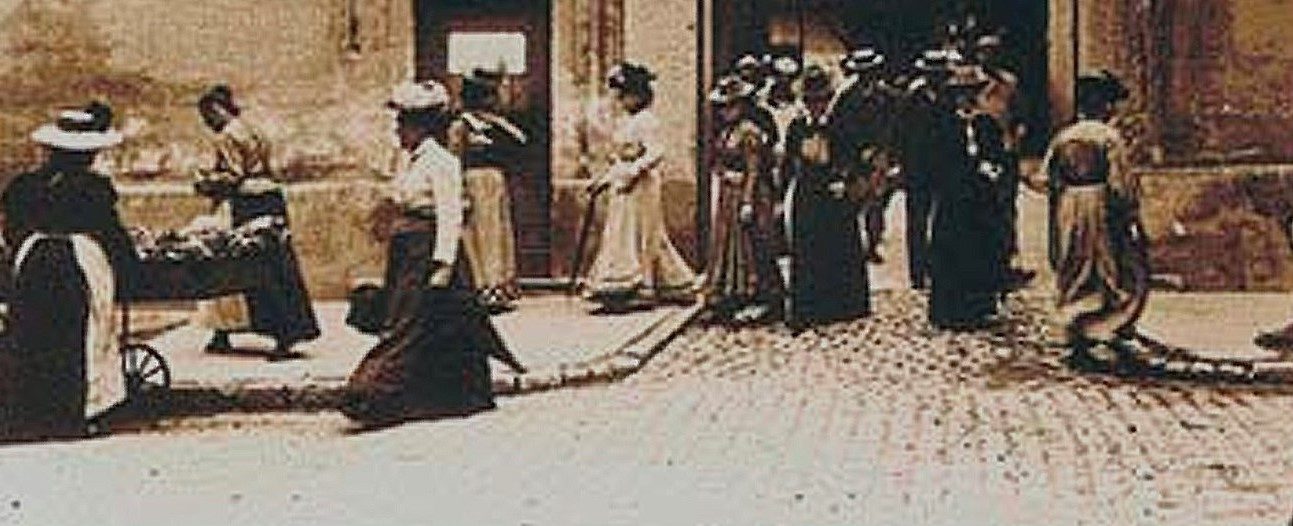France, 1986
Directed by Alain Cavalier
With Catherine Mouchet (Thérèse Martin and later Saint Thérèse of the Child Jesus), Jean Pélégri (Thérèse’s father), Aurore Prieto (Céline), Clémence Massart-Weit (the convent’s prioress), Hélène Alexandridis (Lucie)

Here is a period piece that is shot without teh sets and much of the elaborate reconstruction of the past usually on display in this kind of film. Scenes and sequences are shot in the same, wide-opened space, against a seemingly endless grayish wall, with no visible floor or ceiling and filled with just a few pieces of furniture. The actors quietly move inside this strange space to play their scenes just as the story unfolds; these are performances made into a void ignoring physical realism demanded by the scene: a chat inside a room gives way to an audience with the Pope in a blink within that odd space more akin to a theater stage where any pretense of décor has been discarded than to the powerful means of production cinema has gotten its audience used to.
If decoration is sparse, costumes and props have been carefully researched and the camera keenly focuses on them as they are used by the characters. The bare space of the film actually enhanced the importance of the characters’ gestures and attitudes, usually shot in medium shots or closeups and rarely in long takes – the film favors brief scenes fading out fast, amounting as a collection of short moments capturing those essential gestures and attitudes. No score is played, avoiding that the audience can be distracted from a quiet observation – as silent, indeed, as the nuns are compelled to be by their order’s rules. This is really a movie that draws attention to the way an action segues into another as the lead character follows her narrative arc and fate.
It tells the story, loosely based on actual facts, of the transformation of a young French woman into a religious figure, the path that led Thérèse Martin (1873 – 1897) to become Saint Thérèse of the Child Jesus, one of the rare women recognized by the Roman Catholic Church as a Doctor of Faith, thanks to her essay, “The Story of a Soul”. She is the daughter of a watchmaker who is, when the film starts, a widower; a devout and quiet man, he is tenderly looking after Thérèse and his other daughter, Céline; actually, he is the father of four girls, but the two others are older and nuns in a nearby Carmelite convent. Thérèse feels that monasticism is beckoning at her, but the cautious Church hierarchy is reluctant to let such a young person become a Carmelite; even meeting the Pope barely hastens the process; but Thérèse is eventually accepted.
Most of the film depicts the daily life of Carmelite nuns, emphasizing the tough condition imposed on novices and nuns, highlighting the obsessive separation from the outside world ordered by their rules (the shots featuring the huge wooden grille putting the nuns at a distance from their visiting relatives at the convent’s entrance or showing them covering all their heads when they must talk with a man they do not know well, including doctors) and pointing to personal conflicts and jealousy. But it tracks precisely and vividly the key moments of Thérèse’s life: how the convent’s prioress suggests to her to write her feelings and ideas in a notebook which would grow into the aforementioned book and other essays; how she strikes up a friendship with another novice, Lucie, who is a doubting and undisciplined character but admires and loves Thérèse; the arrival of Céline in the convent after the death of the father; and, above all, the debilitating effect of tuberculosis on her till death comes.
Both the contents of the story and the peculiar way it is shot suggest this should be a stern narration, an austere experience for the audience, a daunting film. The narrative plainly describes the harsh conditions of the convent In fact this is a lively and feisty take on the monastic life and casts the future saint as a perky and brash believer stirred by an enthusiastic and unassailable calling. Catherine Mouchet lends to Thérèse a juvenile strength and a strikingly radiant face that is riveting and endearing without a hint of naivete. Thérèse’s sincerity and bliss cannot be doubted and actually can be shared, thanks to her graceful and optimistic attitudes and gestures – this biopic counter-intuitively avoids relying on the actual words of the saint; it considers that her presence matters more and demonstrates more about her. Her long decline seems an unfair, cruel trial, threatening to undermine her confidence, and the film points to the possibility of despair and even disbelief (which has turned Lucie into a black sheep that would be glad to escape the herd). But she remains a beacon for the other nuns and she dies fully satisfied by her brief life.
More broadly, the austere rules, behaviors and words belie the gentle vision the nuns hold on their place in the world. The Carmelites see themselves as loving servants of the Christ, and their modest goals give them joy and enthusiasm which eerily look akin to the feelings of young lovers. Thérèse, Lucie, the prioress, and others openly talk about Jesus as if He was a lover: their conversations do not convey awe and respect but a strong tenderness that is enough to help them carry on; these words are far more reminiscent of the poetic and intimate vision of the “Song of Songs” than of the stern narration of Saint Matthew in his Gospel (indeed, it is the former the nuns quote). Their celebration of Christmas turns out to be a childish, charming, and candid moment bearing witness to their simple love of Jesus. This is a wonderful, unexpected development and the climax of Thérèse’s quest to be part of the community. Alas, the relentless destruction of her lungs by tuberculosis would accelerate from this point. But even her death is not a tragic and awful moment; it is rather treated in a fit of poetry. It is not shot in fact; instead the camera focuses on a pair of shoes Thérèse used to wear. She has just stopped treading this part of the universe; it could be imagined that she is now walking with her lover in the other part.

